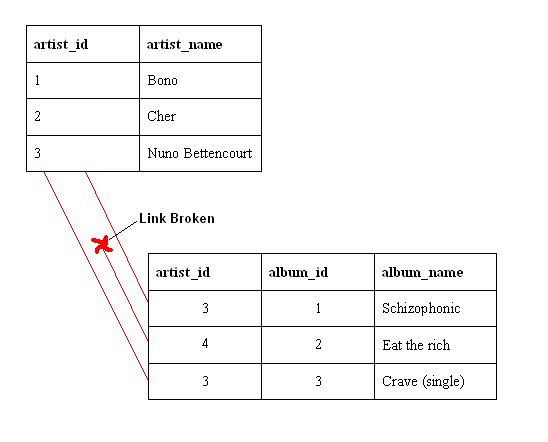
Referential integrity is a property of data stating that all its references are valid. In the context of
relational database
A relational database (RDB) is a database based on the relational model of data, as proposed by E. F. Codd in 1970.
A Relational Database Management System (RDBMS) is a type of database management system that stores data in a structured for ...
s, it requires that if a value of one attribute (column) of a
relation (table) references a value of another attribute (either in the same or a different relation), then the referenced value must exist.
For referential integrity to hold in a relational database, any column in a base
table
Table may refer to:
* Table (database), how the table data arrangement is used within the databases
* Table (furniture), a piece of furniture with a flat surface and one or more legs
* Table (information), a data arrangement with rows and column ...
that is declared a
foreign key
A foreign key is a set of attributes in a table that refers to the primary key of another table, linking these two tables. In the context of relational databases, a foreign key is subject to an inclusion dependency constraint that the tuples ...
can only contain either null values or values from a parent table's
primary key
In the relational model of databases, a primary key is a designated attribute (column) that can reliably identify and distinguish between each individual record in a table. The database creator can choose an existing unique attribute or combinati ...
or a
candidate key
A candidate key, or simply a key, of a relational database is any set of columns that have a unique combination of values in each row, with the additional constraint that removing any column could produce duplicate combinations of values.
A candi ...
. In other words, when a foreign key value is used it must reference a valid, existing primary key in the parent table. For instance, deleting a record that contains a value referred to by a foreign key in another table would break referential integrity. Some
relational database management system
A relational database (RDB) is a database based on the relational model of data, as proposed by E. F. Codd in 1970.
A Relational Database Management System (RDBMS) is a type of database management system that stores data in a structured for ...
s (RDBMS) can enforce referential integrity, normally either by deleting the foreign key rows as well to maintain integrity, or by returning an error and not performing the delete. Which method is used may be determined by a referential integrity constraint defined in a
data dictionary
A data dictionary, or metadata repository, as defined in the ''IBM Dictionary of Computing'', is a "centralized repository of information about data such as meaning, relationships to other data, origin, usage, and format". ''Oracle Corporation, ...
.
The adjective 'referential' describes the action that a
foreign key
A foreign key is a set of attributes in a table that refers to the primary key of another table, linking these two tables. In the context of relational databases, a foreign key is subject to an inclusion dependency constraint that the tuples ...
performs, 'referring' to a linked column in another table. In simple terms, 'referential integrity' guarantees that the target 'referred' to will be found. A lack of referential integrity in a database can lead relational databases to return incomplete data, usually with no indication of an error.
Formalization
An inclusion dependency over two (possibly identical) predicates
and
from a schema is written
 Referential integrity is a property of data stating that all its references are valid. In the context of
Referential integrity is a property of data stating that all its references are valid. In the context of  Referential integrity is a property of data stating that all its references are valid. In the context of
Referential integrity is a property of data stating that all its references are valid. In the context of